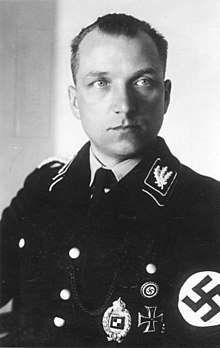August Heissmeyer
August Heißmeyer (or Heissmeyer – 11 January 1897 – 16 January 1979), was a German SS functionary during the Nazi era. He commanded the SS Main Office in 1935–1939. After World War II, Heißmeyer was tried and convicted as a "major Nazi offender".
August Heissmeyer | |
|---|---|
 | |
| Birth name | August Heißmeyer |
| Born | 11 January 1897 Aerzen, German Empire |
| Died | 16 January 1979 (aged 82) Schwäbisch Hall, West Germany (now Germany) |
| Allegiance | |
| Branch | |
| Years of service | 1914–1918 1939–1945 |
| Rank | Obergruppenführer |
| Battles/wars | World War I World War II |
Early life
After finishing school, Heißmeyer joined the Prussian military. In World War I, he was an infantry officer and was awarded the Iron Cross First Class for bravery. After giving up his studies, he was employed as a driving teacher. In 1923 he first came into contact with the Nazi Party, which he joined in 1925. In early 1926, Heißmeyer joined the Sturmabteilung (SA) where he was responsible for building up the SA-Gausturm Hannover-Süd, and was for a time the acting Gauleiter. In 1940 Heißmeyer, previously married with six children in his custody, married Gertrud Scholtz-Klink, the Reichsfrauenführerin (Reich Women's Leader), who had two previous marriages herself.
SS career
Heißmeyer joined the Schutzstaffel (SS) in January 1930. From 1932, Heißmeyer was posted to the SS Main Office, becoming its leader in 1935 and relieving Heinrich Himmler from that specific position. On 9 November 1936, Heißmeyer was promoted to SS-Obergruppenführer (general) and Inspector of the National Political Institutes of Education. In 1939, Heißmeyer was appointed SS Oberabschnittsleiter "East" and in 1940 as HSSPF (Higher SS and Police Leader) Spree, where he was in charge of the Berlin-Brandenburg area.
August Heißmeyer took over the command of the SS Totenkopf Standarte in 1940 from the outgoing Theodor Eicke, who in 1939 had begun commanding a combat SS division (SS Division Totenkopf) and therefore gave his supervision over the concentration camps back to the SS Leadership Main Office. Heißmeyer was provisionally in charge of this bureau until May 1942. Richard Glücks took over the position, and became the chief of the Concentration Camps Inspectorate. In April 1945, Heißmeyer was given command of Kampfgruppe "Heißmeyer", a collection of Volkssturm militia and Hitler Youth who were given the task of protecting the Spandau airfield outside Berlin.
Post-war trial and conviction
On 29 February 1948, Heißmeyer was arrested by French authorities near Tübingen and held for trial the following month. He served 18 months in prison before being released in 1949. The following year he was sentenced by the de-Nazification appeals court to 3 years imprisonment and forfeiture of property as a "major Nazi offender". His nephew Kurt Heissmeyer, an SS physician, was also convicted.
After his release, Heißmeyer went to live in Schwäbisch Hall. He became the director of the West German Coca-Cola bottling plant. He died on 16 January 1979, five days after his 82nd birthday.
External links
- August Heissmeyer in the German National Library catalogue
- Newspaper clippings about August Heissmeyer in the 20th Century Press Archives of the ZBW